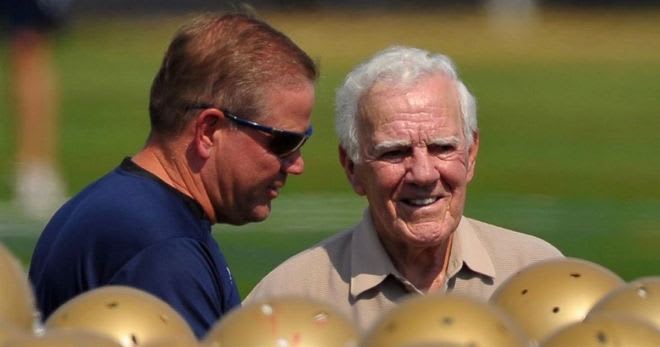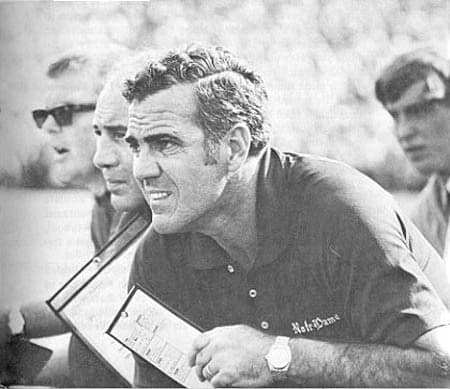Notre Dame's 5-Minute Plan & 'The Three E's' — Revisited

Editor's Note: This July we printed one of our favorite columns that was written by Notre Dame assistant coach to Ara Parseghian (1964-74), Tom Pagna. With the dawn of a new season upon us next week, the Fighting Irish trying to regain respectability after last year’s 4-8 outcome, and the death of Parseghian this month, we thought it apropos to print it again as a theme entering the 2017 season.
At his December 2009 press conference that introduced him as Notre Dame's new head football coach, Brian Kelly indicated that a timetable for turning around Fighting Irish fortunes cannot be made too long term.
"We don't have a five-year plan," Kelly said. "We have a five-minute plan and we'll start to work on it immediately."
More than a half-century earlier, one of Kelly's predecessors at Notre Dame, Ara Parseghian (1964-74) introduced the ultimate "five-minute plan" even prior to accepting the Irish job.
It was predicated not on what to plan for the long term but what can be controlled in the immediate here and now. His former star player and long-time right-hand man, the late Tom Pagna, explained this concept in a column for Blue & Gold Illustrated. It never gets old, and bears repeating.
The greatest sprinters in the world train endless hours and years just to try to be the world's fastest man in a race that lasts about 10 seconds. Likewise, the average college football game lasts approximately three-and-a-half hours — but the actual physical exertion to the players is about five minutes. That was the main theme of what was known as "The Great Interval" during Parseghian's era.
After Parseghian's Northwestern team finished 0-9 in 1957, the fiery young head coach was on the hot seat. He had just completed the second season of a three-year contract, so the clock was ticking.
With his career as a head coach on the line, Parseghian analyzed every detail of the program, from the equipment the players were wearing to off-season habits. During one film study, he broke down the different length of plays. The longest play was usually a kickoff return, about 12 seconds, and the shortest was less than two seconds, a no-gain dive into the line.
On average, an offense will run about 70 to 80 plays per game, as will the defense. Each play averaged about four seconds. So if you multiply four seconds by 70 to 80 plays, it translated into 280 to 320 seconds, or about 5 minutes of live, active, playing time.
Yes, talent was essential. No one could win without it. But the "edge" in a program, or a leg up on others, came from the three E's: Effort, Execution and Endurance. Here is what Pagna had to say thereafter:
"As Ara realized the significance of how little time actually was involved with the game, he asked himself what it was he, as the head coach, was asking of his players. It was an 'interval' of time, five-plus minutes, and what you filled it with that really counted. He settled upon three things he wished to instill within his teams.
"1. Effort — The complete physical explosion of muscle and strength — 100 percent.
"2. Execution — The correct technique to increase the chance for success.
"3. Endurance — Sustaining the activity to the completion of the play.
"Effort, Execution and Endurance meant do it hard, do it right, do it until it is done. Those 'Three E' commands were what the word 'INTERVAL' contained. If you said 'interval' to a player, he knew immediately what it represented. Not only was it the first page in the playbook, it was enforced by the student manager blowing a whistle four seconds after the start of any practice play. This ingrained giving effort until you heard the whistle.
"When Ara asked a room full of young men ready to do battle, 'Can you give Our Lady of Notre Dame 5 minutes of your best time?', it would be very hard to say no. The Great Interval and its creation by a great coach was a turning point for all who understood."
Parseghian improved from 0-9 to 5-4 in his third season (1958), rocketed to No. 2 in the AP poll at one point in 1959, and even made took former Big Ten doormat Northwestern to No. 1 in 1962 after a 6-0 start, including a 35-6 dismantling of Notre Dame (against whom he was 4-0). The best was still to come for him at Notre Dame, where more talent combined with leadership, motivation and The Great Interval would intertwine.
About 60 years later, those rules still aren't outdated for the 2017 Fighting Irish as they attempt their latest rise from the ashes.

----
• Talk about it inside Rockne's Roundtable
• Subscribe to our podcast on iTunes
• Learn more about our print and digital publication, Blue & Gold Illustrated.
• Follow us on Twitter: @BGINews, @BGI_LouSomogyi, @BGI_CoachD,
@BGI_MattJones, @BGI_DMcKinney and @BGI_CoreyBodden.
• Like us on Facebook
